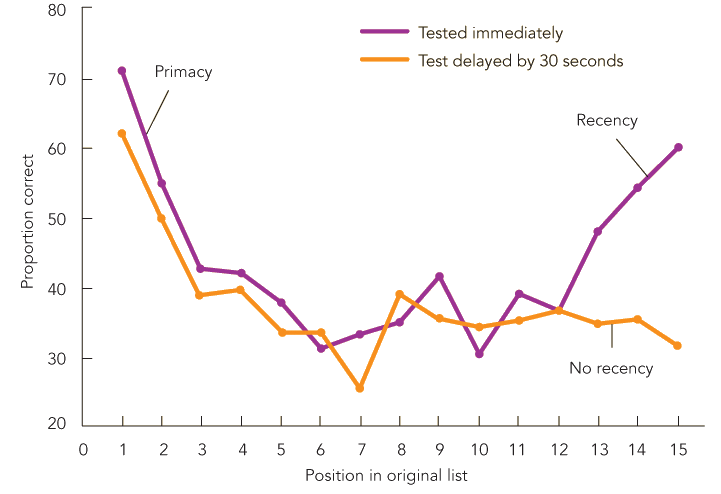
1. Describe the components of the modal model.
2. What is the sensory store? How is it measured?
3. What is the capacity, duration, and coding of the short-term store (STS)?
4. What is the Brown-Peterson task? Is forgetting due to decay or interference?
5. What are the structural and functional components of working memory?
6. How is working memory related to the brain?
Memory includes:
• structures (called “______”) that hold knowledge
• processes that operate on knowledge
• may also refer to the knowledge itself
(Richard Atkinson & Richard Shiffrin, 1968, 1971)
__________ features: stable memory stores
• sensory store
• short-term store (STS) represented acoustically
• long-term store (LTS) is semantic
- based on James’ (1890) primary and secondary memory
- this distinction is similar to computers (RAM vs. hard drive)

_______ processes: routines or strategies a person selects and uses depending on the situation; they include:
• _________: repetition of information; helps transfer information from STS to LTS
e.g., repeating a phone number over and over until you memorize it
• ______: associating to-be-remembered information with already known information
e.g., imaging: using visual images to remember verbal information
• _________ strategies: help focus on to-be-remembered information
e.g., remembering provincial capitals by starting with the west coast and working eastward
Pros & cons:
![]() division of memory is clear and intuitive
division of memory is clear and intuitive
![]() influential in guiding memory research
influential in guiding memory research
![]() oversimplified structures and processes of memory
oversimplified structures and processes of memory
![]() overstated the role of rehearsal in remembering
overstated the role of rehearsal in remembering
George Sperling (1960): What is the duration of the sensory store?
Part I: _____ report method
- flashed matrix of letters on screen for 50 ms
- recall rate was 4.5 out of a 12-letter matrix (38%)
Part II: _______ report method
- matrix flashed on screen
- delay
- cue tone presented, indicating which row should be recalled
- brief delay: tested recall for desired row was 3.3 out of 4 (82%)
- accuracy declined as delay period increased
- implied complete image was temporarily stored before decaying
- “______ _____” duration ~200-400 ms
- same result if cued to ______, when coloured letters were scattered in a matrix
Darwin, Turvey, & Crowder (1972):
- three-_____-person task:
left ear: |
both ears: |
right ear: |
B |
8 |
F |
2 |
6 |
R |
L |
U |
10 |
- partial report cue: visual bar on left, middle, or right
- longer delay: poorer recall
- “______ _____” duration ~2-4 s
Sensory stores also exist for touch, smell, and taste
Function: allows extraction of limited amounts of information to ___
George Miller (1956):
- _____-____ task: try to recall a given a list of numbers
- capacity: “The Magical Number _____, Plus or Minus Two: Some Limits on Our Capacity for Processing Information”
However, more recent work (Baddeley, 1994; Cowan, 2001) indicates that STS capacity is four, plus or minus one.
STS unit is a _____: well-learned unit of components, representing consistent or meaningful pattern
• chunking combines units into a larger chunk, and reduces amount to be remembered
• application: ________
e.g., “Roy G. Biv” tells you the colours of the rainbow
Chase & Simon (1973): How are expertise and STS related?
- participants: chess masters, intermediates, novices
- shown chess boards for 5 s:
• ______ chess boards: masters’ recall superior
• ______ pieces: equal performance
- experts have better domain-________ memories of patterns that form chunks
Chase & Ericsson (1981):
- trained long-distance ______ S.F. to expand digit span using chunking
e.g., sequence 3 4 9 2 would be encoded as 3 min 49.2 s (near world-record time for the mile)
- expanded digit span from 7 to 79 digits with 230 hours of practice
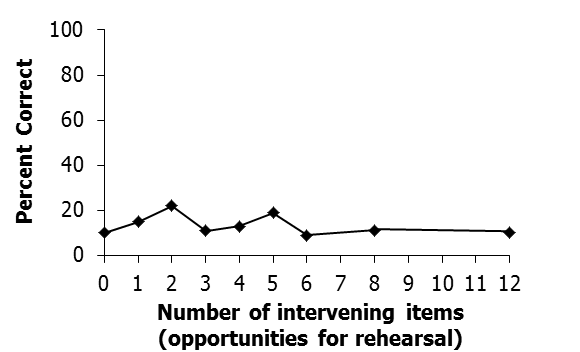
Peterson & Peterson (1959; also Brown, 1958): How long is short-term storage?
- participants told to remember 3 consonants & 3-digit number
- during retention interval, had to count backwards by 3s
e.g. given “S B J, 394”, count 391, 388, 385,...
- after a certain amount of time, recall the 3 letters
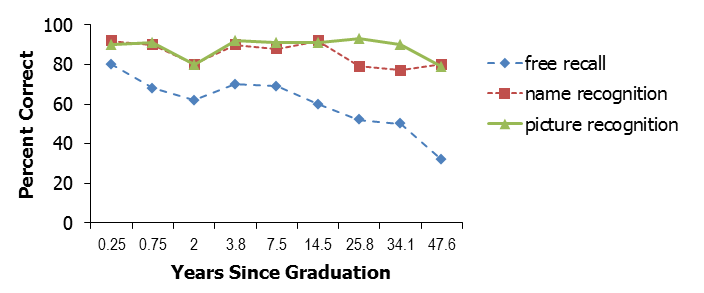
- their conclusion: STS ______ in less than 20 seconds without active rehearsal
Problem:
Keppel & Underwood (1962):
- performance declined over trials
- previously used letters __________ with current memory!
Waugh & Norman (1965)
- list of 16 digits (last = “probe digit”), then a tone
- what digit came after the probe the first time it occurred in the list?
e.g., 7 9 5 1 2 9 3 8 0 4 6 3 7 6 0 2 (tone), respond: “9”
- presentation rate of 1/s or 4/s
- decay prediction: less recall with slower rate
- interference prediction: no difference due to rate
- results: presentation rate had little effect on recall
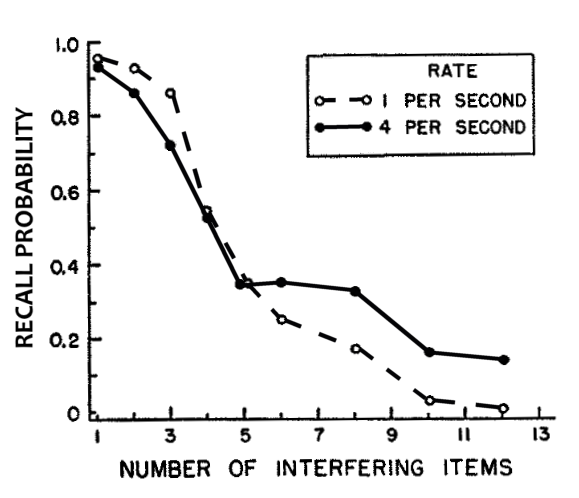
- conclusion: interference, not decay, is the primary cause of forgetting
• ___________ interference: new information replaces older information
e.g., Windows 3.1 paste command was...?
• _________ interference: already-learned information makes it harder to remember new information
e.g., Power 92.5 FM now called...?
Barnes & Underwood (1959):
- participants learned a list of paired-associate words until perfect recall (A-B list)
e.g., chair-dog
- then learned a second list with the first terms paired with new words (A-C list)
e.g., chair-tree
(studied this second list 1, 5, 10, or 20 times)
- memory was tested for both associated terms
e.g., given chair, respond with dog and tree
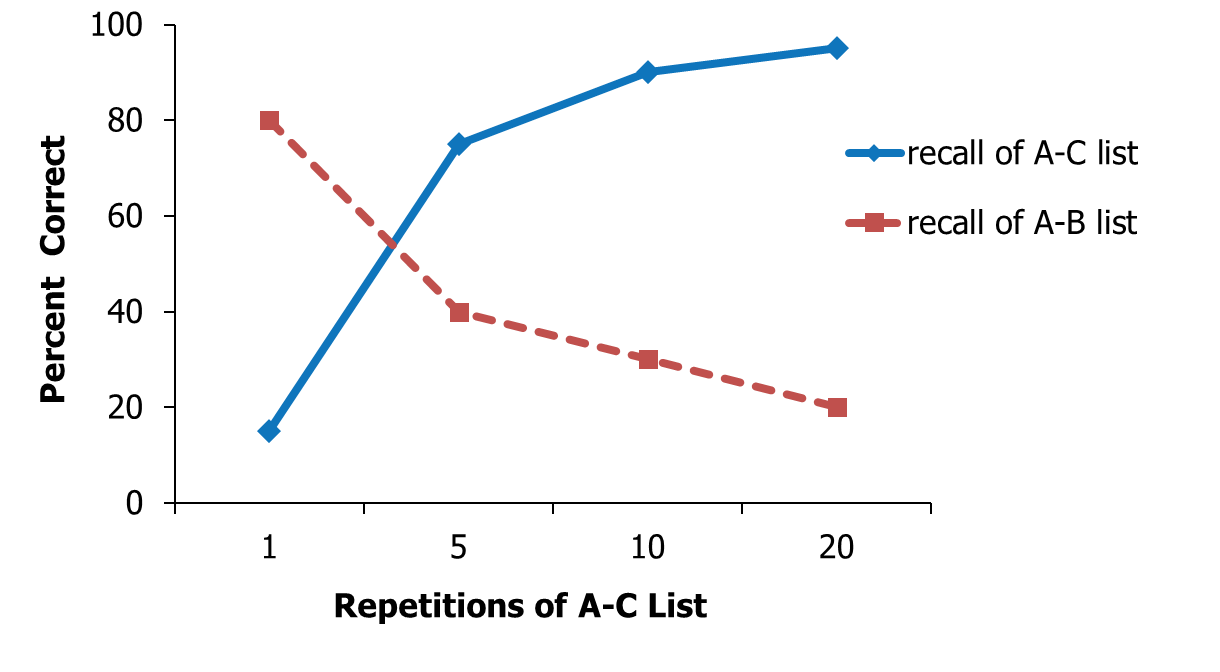
- recall of A-B list is interfered with by the memory for A-C list (___________ interference)
Wickens, Born & Allen (1963):
- participants heard several lists of words from same category
(dogs)
- recall declined after a number of trials
- on the final trial, words were from a different category
(flowers)
- recall ________
- _______ from proactive interference
Acoustic:
• ____________ similarity effect (Conrad, 1964):
- letters were presented ________
- participants then wrote them down
- more interference among similar-sounding letters
(e.g., B C P T V vs. F M N S X)
- 75% of errors from same acoustical class
- few visual errors
(e.g., E vs. F, O vs. Q, R vs. P)
• ____ ______ effect memory for shorter words is better than for longer words
e.g., digit spans for different languages (Naveh-Benjamin & Ayres, 1986):
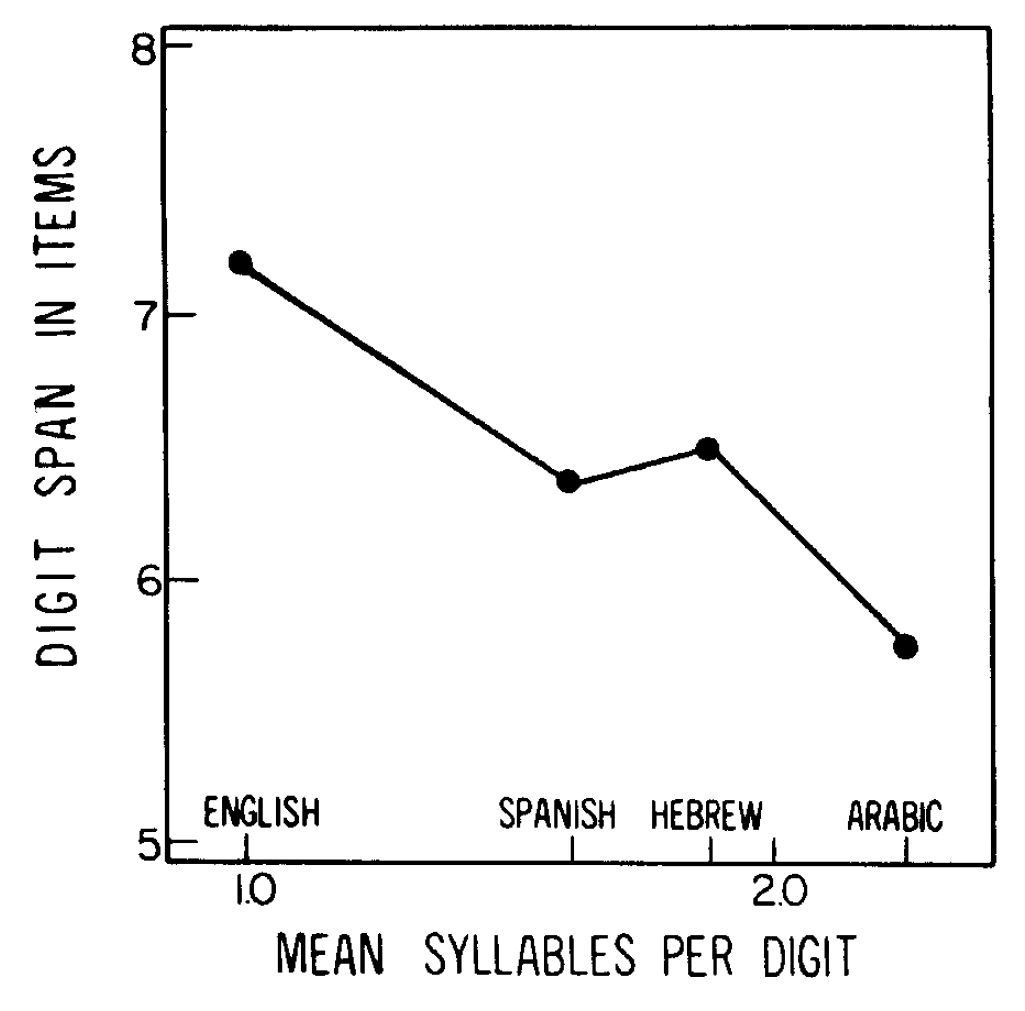
- this effect is a function of how long it takes to read the words out loud
• articulatory ___________: repeating word (e.g., “the”) during retention interferes with memory
Visual:
Posner & Keele (1967):
- showed letters, same or different in name and/or form:
e.g., AA, Aa, AB, or Ab
- measured RT to decide same name:
e.g., AA (same), Aa (same), AB (different)
- took longer to decide same name/different form (Aa) than same name/same form (AA)
- implies ______ code in STS
Brooks (1968): ____________ effects
Tasks:
- sentence: read a sentence, then from memory, make judgments about each word (is it a noun?)
- diagram: see block letter, then from memory, go around it clockwise and make judgments about each corner (is it at the _______ top or bottom of the letter?)
Response modes:
- verbal: say “yes” or “no”
- pointing at spatial arrangement of Ys and Ns
e.g., sentence task with verbal response mode:
“A bird in the hand is not in the bush.” Is each word a ____?
(correct sequence: N, Y, N, N, Y, N, N, N, N, Y)
e.g., diagram task with pointing response mode:
*L |
Y |
N |
|||
Y |
N |
||||
Y |
N |
||||
Y |
N |
||||
Y |
N |
||||
Y |
N |
(correct sequence: Y, Y, Y, N, N, Y)
Results (time in seconds):
Response mode: |
||
Task: |
verbal |
pointing |
sentence |
13.8 |
9.8 |
diagram |
11.3 |
28.2 |
- spatial response mode (pointing) __________ with imagery (diagram task)
- performing two similar tasks at the same time causes interference between them, but two different tasks does not
- this shows that verbal and visuospatial memories are ________
Conclusion:
• STS generally codes physical details; however, it may also code semantically
Alan Baddeley (1974, 1976, 2000, 2018):
In contrast to the storage-based view of STS, working memory includes the processing of information
Components:
• ____________ loop:
- phonological store: passively stores speech sounds
- articulatory rehearsal process: actively processes items to prevent decay
• ____________ sketchpad:
- visual cache: stores form and colour information
- inner scribe: handles spatial and movement information; rehearses visual information; also transfers information in visual cache to central executive
• _______ _________:
- controls attention
- coordinates other components
- transfers information to/from long-term memory
- time sharing of multiple tasks
e.g., generating random numbers is worse while alternating reciting alphabet and counting
• ________ buffer:
- interfaces with episodic long-term memory storage (holds personal life experiences)
- integrates information into a single complex structure or experience
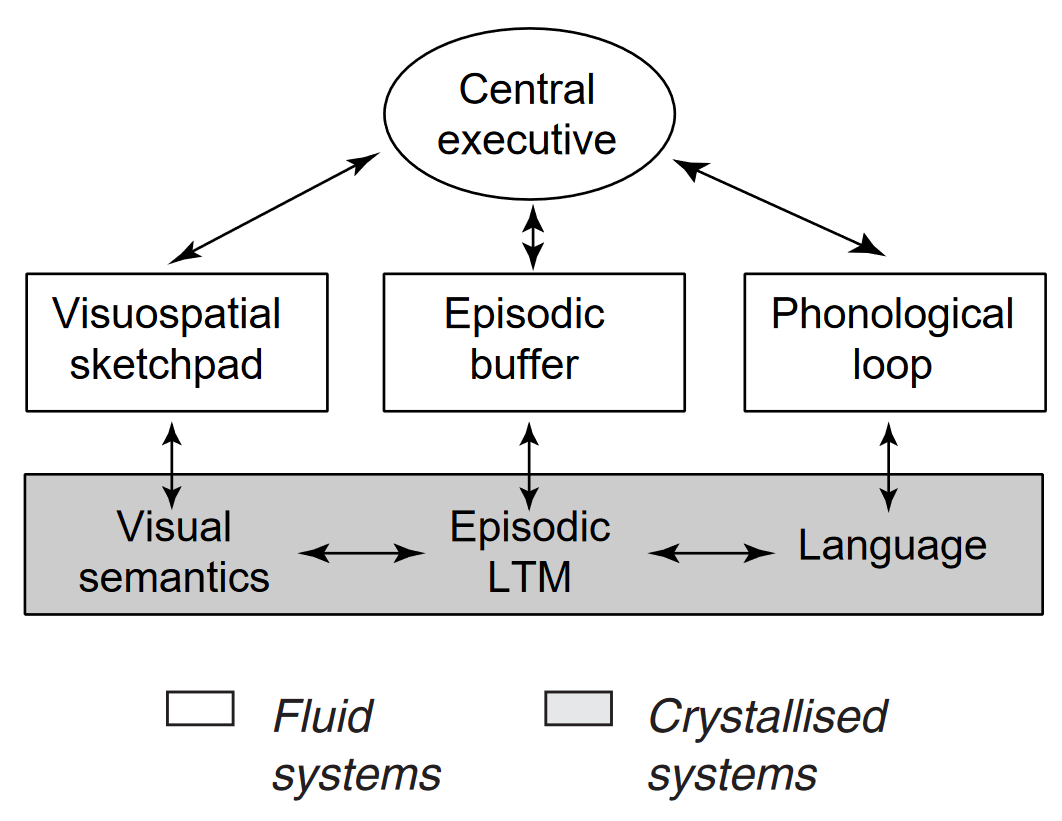
General:
- fluid systems include attention and temporary storage, whereas crystallized systems accumulate long-term _________
- all components have limited ________
- if two tasks use the same component, they cannot be performed successfully ________
Pros & cons:
![]() conceptualizes active processing and transient storage of information
conceptualizes active processing and transient storage of information
![]() can be applied to _______ tasks
can be applied to _______ tasks
![]() role of central executive is vague
role of central executive is vague
![]() it is unclear how components interact
it is unclear how components interact
Smith & Jonides (1997): How is working memory related to the brain?
- participants given verbal memory or spatial memory task while in a PET scanner
• verbal task: presented 4 target letters; delay; probe letter presented: Did probe match any target letter?
• spatial task: presented 3 dots at different locations; delay; circle presented: Was a dot located within the circle?
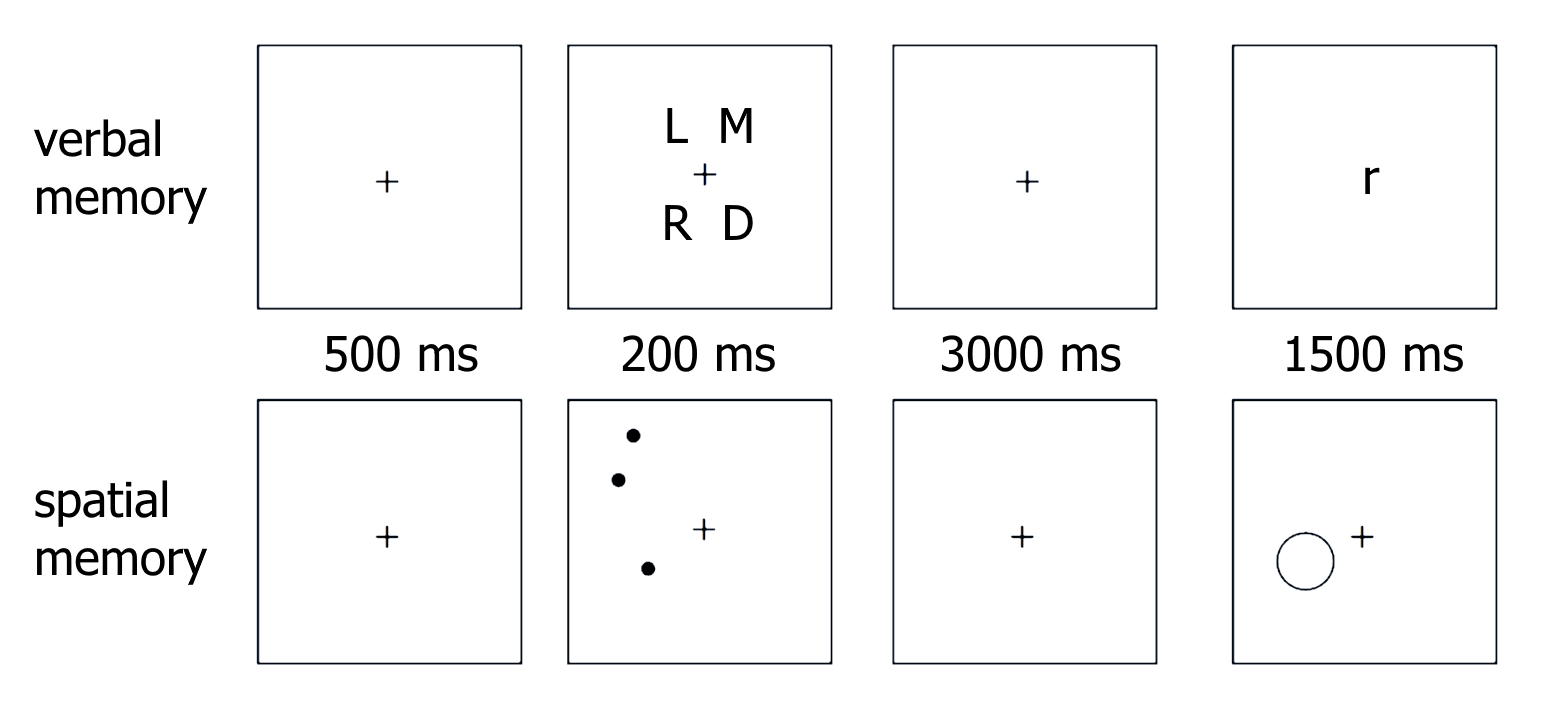
- brain activation from a related control task not requiring working memory was __________
- results:
• verbal task: activated posterior parietal, Broca’s, premotor, and supplementary motor areas in left hemisphere
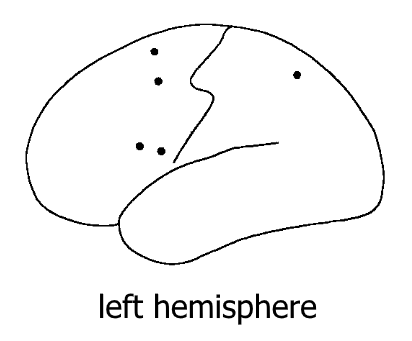
• spatial task: activated posterior parietal and premotor areas in right hemisphere
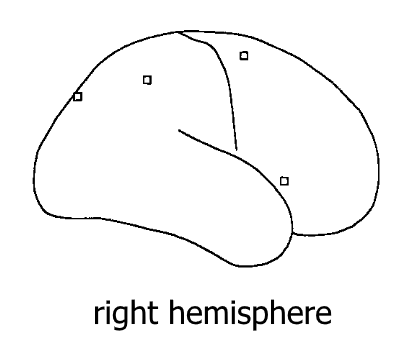
- conclusions:
• ______-____________ evidence for different systems for verbal (left hemisphere) vs. spatial information (right hemisphere)
• as memory load increased, corresponding brain regions showed increase in activity
• may be ________ components for passive storage (generally located toward the back of the brain) vs. active processing (more in the frontal lobes)
Other research has implicated the central executive as a function of the __________ cortex, whereas the episodic buffer seems more broadly distributed.